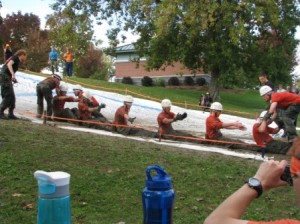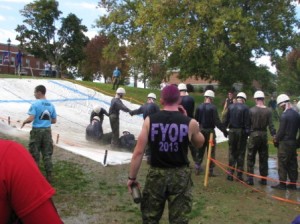On-time delivery of compliant, responsive, persuasive proposals for RFPs requires advanced teamwork and best practices. Lessons for both can be found in many venues, not least military training.
Just back from the reunion weekend at the Royal Military College in Kingston. Not a graduate of that institution myself, I am the guest of an ex-cadet from the Class of ’68. For me, much of the weekend is spent in what comedian Steven Wright calls “reminiscing with people I don’t know.” But the obstacle course is undeniably grand.
It’s run by the recruit class as the culmination of their five-week recruit term: the last thing between them and becoming a full-fledged cadet. The twelve challenges test them physically and mentally.
One event requires them to get themselves and two jerry cans of gasoline to the top of a steep slope that is covered in plastic, slicked down with soap, water, and mud. As older cadets blast water on the slope to keep it sporting, the first recruits arrive and put on blindfolds that also protect their eyes. We watch as they execute their plan of attack under the direction of their mentors, upper-year cadets who are there to advise, not to participate directly. The first recruit sits down; the second feels his way into place and wedges in behind, propping his feet against the first guy’s back. One by one they gradually string themselves up the hill in a stable, non-slipping configuration. As the last one gets into place, the jerry cans are passed hand-to-hand up this human chain. As the second can reaches the top of the hill, the bottom cadet stands up and they all troop upwards, holding hands so no one slips away.
As the next team arrives with their upper-year outriders, it’s obvious that this group has a different plan. They make a chain at the outset, getting themselves stretched out on the hill in about half the time. Outriders from the same cadet squadron move through the crowd, shushing the watchers so the recruits can hear the instructions their handlers are shouting.
It’s a nice point, and it highlights how the knowledge of the best method for tackling this challenge—what businesses like to call “best practices” these days—is transmitted. Like the skipping songs on the schoolyard, the transmission is kid to kid (cadet to cadet in this case), with no intervening adult (or teacher/instructor) in this chain.
It’s like that in Proposal Land, too, where people learn to do proposals by doing them and by working with others who’ve done them before. A little formal orientation and training would not seem amiss, but it’s rarely done.


